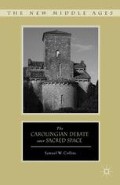Abstract
At Histories 7.42 Gregory of Tours tells how the count of Bourges, in an effort to put together funds for an upcoming war, levied arbitrary fines on the local religious houses. He sent a band of his servants, thuggishly described as his pueri, to a local oratory dedicated to St. Martin whose custodians had ignored the fines, in an effort to collect the money by force. The overseer of the oratory tried to warn the leader of this band of his peril. This leader, however, fixated on the money and dismissive of the potential anger of the saint, ignored the overseer. Gregory relates what happened next:
he [the leader of this band] marched into the forecourt of the house [atrium domus]. He immediately fell on the ground in great pain and became extremely ill. He turned to the overseer and said in a feeble voice: “Make the sign of the cross over me, I beg you, and call upon the name of Saint Martin. I fully recognize how great is his miraculous power. As I walked into the forecourt of this place, I saw an old man holding in his hand a tree, the branches of which spread out until they soon covered the whole room. One of the branches of that tree touched me, and I was so affected by the contact that I collapsed.”1
Access this chapter
Tax calculation will be finalised at checkout
Purchases are for personal use only
Preview
Unable to display preview. Download preview PDF.
Notes
On the development of palace culture: Stuart Airlie, “The Palace of Memory: the Carolingian Court as Political Centre,” in Courts and Regions in Medieval Europe, ed. S. R. Jones, R. Marks, and A. J. Minnis (York: York Medieval Press, 2000): 1–20. On Aachen as a kind of theater for this new palace culture: Janet Nelson, “Aachen as a Place of Power,” in Topographies, ed. de Jong, 232–34 [217–41] and Sot, Michel. “Le palais d’Aix, lieu de pouvoir et de culture,” in Le monde carolingien: bilan, perspectives, champs de recherches, ed. Wojciech Falkowski and Yves Sassier (Culture et société médiévales 18, Turnhout: Brepols, 2009): 243–62.
Ross Sampson, “Carolingian Palaces and the Poverty of Ideology,” in Meaningful Architecture: Social Interpretations of Buildings, ed. M. Locock (Aldershot: Boydell and Brewer, 1994): 99–131, argued against any thoroughgoing ideological consistency or intended set of meanings in the Carolingian palace complexes.
On the Carolingian interest in the imperial Roman past, see Janet Nelson, “Translating Images of Authority: the Christian Roman Emperors in the Carolingian World,” in Images of Authority: Papers Presented to Joyce Reynolds on the Occasion of Her 70th Birthday, ed. M. M. Mackenzie and C. Roueché (Cambridge: Cambridge University Press, 1989): 94–205.
Beat Brenk, “Spolia from Constantine to Charlemagne: Aesthetics Versus Ideology,” Dumbarton Oaks Papers 41 (1987): 103–09, and McClendon, Origins, 112–13.
David and the Temple of Solomon: Mayke de Jong, “Charlemagne’s Balcony: the Solarium in Ninth-Century Narratives,” in The Long Morning of Medieval Europe: New Directions in Medieval Studies, ed. Jennifer Davis and Michael McCormick (Aldershot: Ashgate, 2008): 284–90 [277–90]. Revelation and numerical symbolism: Janet Nelson, “Charlemagne’s Church at Aachen,” History Today Uan. 1998): 62–63, with the skeptical comments of McClendon, Origins, 109.
Copyright information
© 2012 Samuel W. Collins
About this chapter
Cite this chapter
Collins, S.W. (2012). Conclusion: Two Churches. In: The Carolingian Debate over Sacred Space. The New Middle Ages. Palgrave Macmillan, New York. https://doi.org/10.1057/9781137295057_6
Download citation
DOI: https://doi.org/10.1057/9781137295057_6
Publisher Name: Palgrave Macmillan, New York
Print ISBN: 978-1-349-43385-8
Online ISBN: 978-1-137-29505-7
eBook Packages: Palgrave Literature CollectionLiterature, Cultural and Media Studies (R0)

